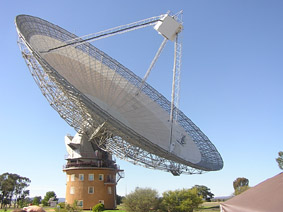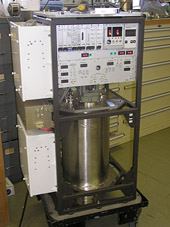SAO Student News
For each SAO e-zine, we would like to share some of the exciting astronomy news stories from our students. If you have an item that you would like included in future e-zines, please let us know. News Item In May 2007, HET607 student Graeme Knight visited the Parkes Observatory. Graeme sent us this report:-
"In early May, I had the privilege of visiting Parkes Radio Telescope. The weekend was arranged as part of the
Wireless Institute of Australia's Annual General Meeting. Approximately one hundred and twenty amateur radio enthusiasts
(Hams), descended on the town of Parkes for a wonderful and interesting weekend.
Friday evening saw us at the telescope visitors centre for an enjoyable dinner at "The Dish Cafe", and a most interesting
meeting hosted by the Central West Astronomical Society. The speaker was Dr Geraint Lewis, Associate Professor at the
University of Sydney, his topic, "The Runaway Universe: The influence of Dark Energy". The presentation was followed by
some observing through several CWAS telescopes.
At the Saturday AGM dinner, we were entertained by an interesting presentation on model rocketry, and then of course the
movie "The Dish", to get us in the mood for our tour the next day. Although as with most movies, there are certainly
embellishments that perhaps diverge from some of the facts. However it is a very entertaining movie, which perhaps
contributes towards some awareness of the scientific achievements that Australia has been party to. For more information
on Parkes involvement with the Moon landing, visit
http://www.parkes.atnf.csiro.au/apollo11/
On Sunday morning, with the car park full of vehicles brisling with antennas, (I'm sure the Parkes engineers would have
been cringing!), we set out for an interesting day at the telescope. We were of course all reminded to have radios
turned off, as the area is very sensitive to radio frequency interference. It is interesting to note that a scale model of the telescope
in the visitors centre, had been temporarily out of order due to the radio frequency interference it emitted. An example of how extremely
sensitive the equipment is.
Six groups of twenty people were escorted through the telescope during the day. It was an opportunity to speak with the
staff, and ask questions about the history and operations of an extremely important scientific facility.
The three story building is host to a huge range of leading edge technology and equipment. The tour guide remarked, "now
you will of course see many knobs and switches on your tour through the facility, however it would be appreciated if you
could resist the temptation of pressing any!". I humoured at the thought of one hundred and twenty Radio Hams walking
through such a facility, and not having the urge to press just one button! However everybody must have behaved themselves,
because I heard of no occurrences of the Moon being lost or of failed generators during the day.
It was also a pleasant surprise to catch up with Swinburne's Joris Verbiest [current PhD student and SAO project
supervisor], who is currently conducting research on pulsars.
One of the interesting aspects of the tour was being able to see various receiving equipment, such as the Galileo
receiver, Mars receiver and a 1.42 GHz hydrogen line receiver. These receivers need to be super cooled to increase
the signal to noise ratio for maximum sensitivity.
 |
 |
 |
 |
Bottom row: equipment rack and 1.42 GHz receiver.
-
The tour was most beneficial for my SAO studies, and has given me further incentive to assist the Bendigo District
Astronomical Society with the implementation of a radio astronomy program, of which will be of benefit to our local
education community.
The staff at Parkes should be congratulated for their patience and friendly service during our visit to the
facility. Thanks also to the WIA for arranging a great weekend! I would recommend a visit to anyone should you get the
opportunity. For more information on tours at Parkes, visit their website at
http://outreach.atnf.csiro.au/events/opendays
Graeme Knight, VK3VGK
-
Harper, B. (2006), "Comet Hally 1910: A Local Experience", The Antiquarian Astronomer
(Journal of the Society for the History of Astronomy), p57
Indermuehle, B., Burton, M.G. and Maddison, S.T. (2006), The History of Astronomy in Antarctica",
26th meeting of the IAU, 22-23 August, 2006 in Prague, Czech Republic, SPS7, #24
Lawrence, J.S. et al. (including Indermuehle, B.) (2006), Site testing Dome A, Antarctica",
in Ground-based and Air borne Telescopes, Ed. L.M. Stepp, Proceedings of the SPIE, vol 6267, p62671L
Lenc, E. and Tingay, S. (2006), "The Subparsec-Scale Radio Properties of Southern Starburst
Galaxies. I. Supernova Remnants, the Supernova Rate, and the Ionized Medium in the NGC 253 Starburst", AJ, 132, p1333







